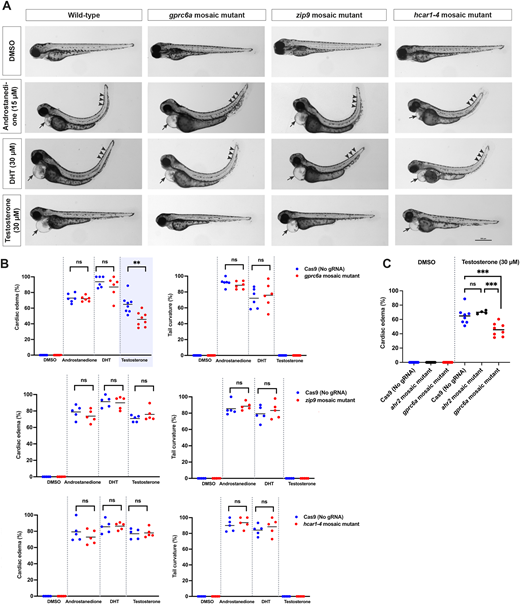Fig. 4 Testosterone phenotype is partially rescued by CRISPR targeting gprc6a. One-cell stage embryos were injected with Cas9 protein alone or together with a cocktail of four guide RNAs targeting different regions of the indicated genes (gprc6a, zip9 and hcar1-4). At 3 h post-fertilization, embryos were exposed to vehicle (0.1% DMSO), 5α-androstane-3,17-dione (androstanedione), dihydrotestosterone (DHT) or testosterone. (A) Representative images of embryos at 3 days post-fertilization. Cardiac edema and tail curvature are indicated by arrows and arrowheads, respectively, except in gprc6a mosaic mutants after testosterone exposure. Lateral views with anterior to the left, dorsal to the top. Scale bar: 500 μm. (B) Percentage of embryos exhibiting cardiac edema (left graphs) or tail curvature (right graphs). Each data point is the percentage of embryos in a single clutch exhibiting cardiac edema or tail curvature (25-160 embryos per clutch). Horizontal lines are the mean of each clutch. Clutches in the same treatment group were assayed on different days. (C) As an additional control, embryos were injected with Cas9 protein alone or with guide RNAs targeting an unrelated gene (ahr2), and then exposed to vehicle or testosterone. The percentage of embryos with cardiac edema was assayed at 3 days post-fertilization. Each data point represents a single clutch (35-70 embryos per clutch). ns, not significant (P>0.05); **P<0.01, ***P<0.001; one-way ANOVA with Tukey's multiple comparisons test.
Image
Figure Caption
Acknowledgments
This image is the copyrighted work of the attributed author or publisher, and
ZFIN has permission only to display this image to its users.
Additional permissions should be obtained from the applicable author or publisher of the image.
Full text @ Development

